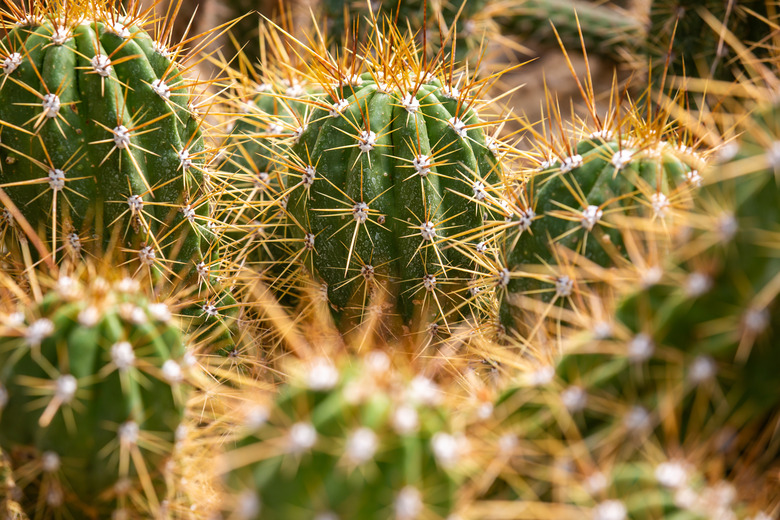Characteristics Of A Cactus
We may receive a commission on purchases made from links.
At a broad level, cacti have a lot of characteristics in common with other plants. They possess chlorophyll and make sugar by combining carbon dioxide and water through photosynthesis. They also have true flowers, reproduce sexually by means of seeds and have water-absorbing roots. On the other hand, cacti have a number of characteristics that make them quite different, at least superficially, from other flowering plants. Many of these characteristics are adaptations for surviving drought.
Water Storage in Succulent Stems
Water Storage in Succulent Stems
In botany, the term "succulent" refers to drought-tolerant plants that have tissues modified for water storage. Jade plants (Crassula ovata, USDA zones 11-12) and houseleeks (Sempervivum tectorum, USDA zones 3-8), with their plump water-storing leaves, are two examples. The vast majority of cacti are also succulents, adapted to living in the arid regions of North and South America, although some types of cacti are native to tropical environments. Whether you're growing a desert or tropical cactus, the stems or leaves store water to sustain them during dry periods.
Cactus Spines Replace Leaves
Cactus Spines Replace Leaves
The lack of leaves is another water-preserving characteristic of some cacti. Leaves have a lot of surface area and therefore lose a lot of water. Only a handful of cactus species, such as those in the tropical genus Pereskia, have true leaves. These primitive, leafy types of cacti also have non-succulent stems. Desert cactus types have sharp spines instead of leaves. The spines, which are modified leaves, protect the juicy, water-filled stem from thirsty desert animals.
A Thick Cuticle Covering
A Thick Cuticle Covering
Like most succulent plants, cacti possess a thick, waxy outer covering known as a cuticle. On some cactus species, the cuticle is so thick that you can scratch wax off the plant with a fingernail, although loss of the wax can damage the plant. The cuticle keeps water stored inside the plant from evaporating into the outside atmosphere. The cuticle also protects the cactus from germs that may try to invade through the skin. It serves as a protective barrier for the plant.
The Metabolism of Cacti
The Metabolism of Cacti
Since a cactus is covered in a waxy cuticle, the main way a cactus can lose water is through its stomata. These are microscopic pores in a plant's skin that let in the carbon dioxide that a plant needs to make sugar. When the stomata are open, water vapor inside the plant easily escapes. To minimize this loss, cacti only open their stomata at night, a system known as crassulacean acid metabolism, or CAM. Other plants that use CAM include pineapples and leafy succulents.
A Photosynthesizing Stem
A Photosynthesizing Stem
All green parts of a plant can photosynthesize, but leaves usually carry out most of the work of photosynthesis. In fact, the stems of most leafy plants have few or no stomata to supply nearby photosynthesizing cells with carbon dioxide. In leafless cacti, however, the stems are the main photosynthesizers. Therefore, cactus stems have more stomata than do the stems of leafy plants, although less than leaves typically do. According to Arthur Gibson and Park Nobel in The Cactus Primer, cacti have 15 to 70 stomata per square millimeter, while leaves have more than 100. This is a significant difference.
